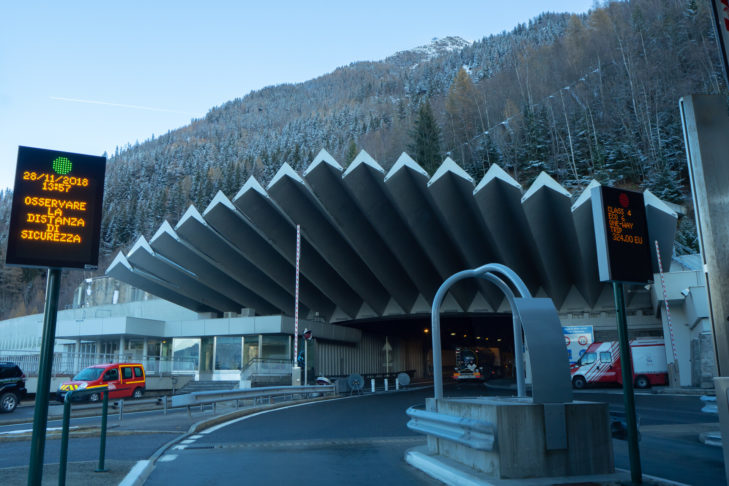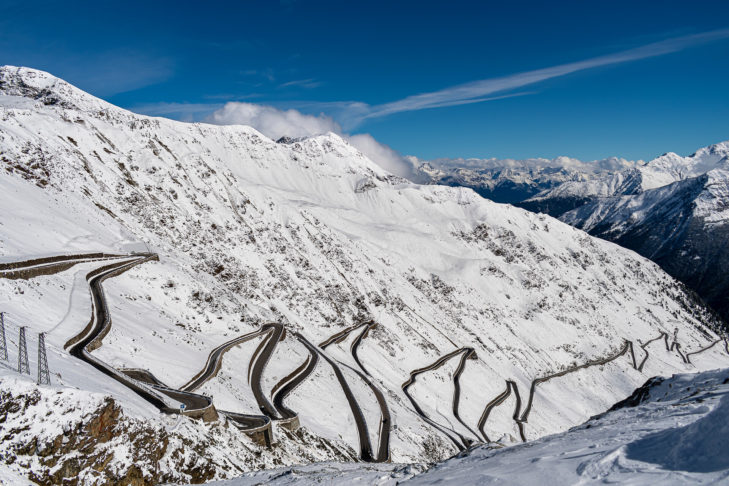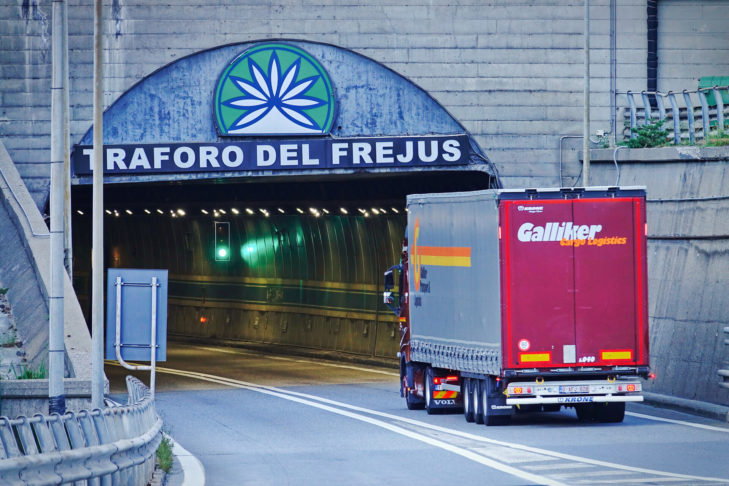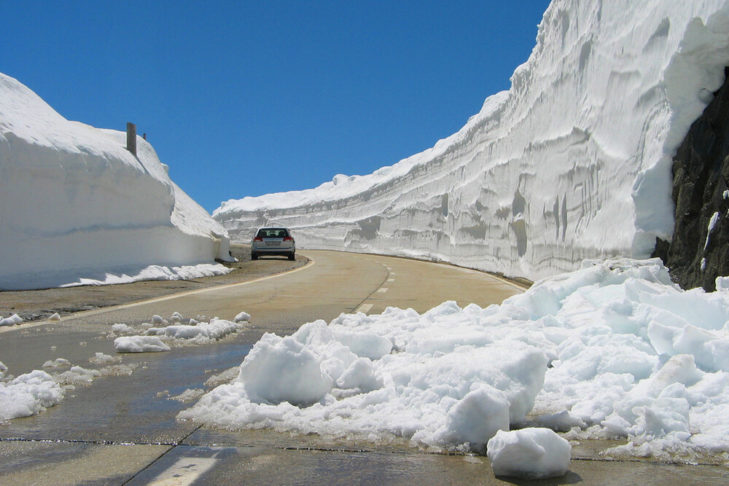Most winter holidaymakers still plan their journey to the ski resort in their own car. However, there are often uncertainties regarding toll costs when crossing the Alps: Do I have to pay tolls on the way to my skiing holiday in 2024? And if so, can I arrange this in advance so that I don’t have any stress en route? SnowTrex knows all about tolls and explains where winter sports enthusiasts have to pay when travelling to the ski resort on the motorway, on pass roads or before Alpine tunnels.
How much do motorway tolls cost drivers in Europe?
| Country | Motorway toll | Costs |
|---|---|---|
| Österreich | Yes | 11.50 Euros (9,55 pounds) (10-day vignette for cars) |
| Italien | Yes | 0.07 Euros (6 pence) (per kilometre by car) |
| Frankreich | Partially | 0.09 Euros (7 pence) (per kilometre by car) |
| Schweiz | Yes | 44.00 Euros (36.52 pounds) (annual vignette) |
| Deutschland | No | 15.10 to 51.60 cents (12,53 to 42,83 pence) (per kilometre for trucks over 3.5 t) |
| Tschechien | Yes | 11.00 Euros (9,13 pounds) (electronic 10-day vignette for cars) |
| Slowenien | Yes | 16.00 Euros (13,28 pounds) (electronic 7-day vignette for cars) |
What are motorway tolls?
Tolls, also known as road tolls, are area-based charges for the use of transport structures such as roads, bridges, country roads, motorways and tunnels. Tolls are rarely charged in Germany, but when travelling abroad, holidaymakers should be aware of which charges apply in which country.
There are basically two types of toll: the time-based access toll and the usage-based route toll. With the first type of toll, the motorist receives an access authorisation for the use of certain traffic facilities without the actual use being important. Access to the transport facilities is usually limited in time and is usually charged via a motorway vignette, as in Austria. In the case of usage-based tolls, the driver pays at a toll station depending on actual usage. In this case, the toll is mainly defined geographically, for example according to the distance travelled or the sections of road used. Many holidaymakers have long been familiar with this type of toll from French motorways.
Countries pursue different objectives when levying tolls. Among other things, the charges serve to finance existing or future road infrastructure, to relieve the environment through a hoped-for reduction in motorised traffic and to generate additional revenue for public budgets.
Tolls in Austria
Austria is one of the most popular winter sports destinations in Europe. However, anyone travelling to the Alpine republic in their own car or in a hire car should be aware that motorway toll stickers are compulsory. There are different validity periods: ten days, two months and one year. The “Pickerl”, as the Austrians call the vignette, can be purchased in two ways. The classic version is a sticker that is visibly attached to the inside of the car windscreen. Another, relatively new variant is the electronic vignette. Just as the classic vignette can be purchased in advance, the digital version can also be booked in advance. However, drivers should note that the validity of the electronic vignette begins 18 days after booking at the earliest. The reason for this is Austrian legislation. It is therefore best to book the vignette and your skiing holiday in Austria well in advance.
The same price applies to both vignette variants, which is 96.40 euros (80,01 pounds) for the annual vignette for vehicles up to 3.5 tonnes in 2024. If you opt for the 10-day vignette and drive a car, you can expect to pay 11.50 euros (9,55 pounds). The vignette tariffs are adjusted annually to the harmonised consumer price index (HICP) in accordance with the statutory provisions, which leads to a regular price increase of around 2%.
Also important to know when travelling by car to Austria: in addition to the routes subject to toll stickers, which incidentally start just over the border, there are also special toll routes such as the Arlberg Tunnel (11.50 euros (9,55 pounds) for a single journey by car) or the Brenner motorway (11.00 euros (9,13 pounds) for a complete journey by car). Here, the toll in Austria must be paid separately on the way to skiing – or a toll-free route must be used.
Tolls in Italy
While Austria and Switzerland have time-based vignettes, Italy has a distance-based toll system. This means that it depends on the route winter holidaymakers take by car. The motorway toll on a ski trip is therefore based on the actual kilometres driven. Drivers therefore do not have to buy a vignette or similar in advance. Instead, the motorways in Italy are dotted with toll stations where drivers take a ticket, which they pay at the station where they leave the motorway. The toll stations cannot be overlooked, as there is no other option but to drive past them.
In terms of costs, motorists can expect to pay around 7 cents (6 pence) per kilometre (as of 2024). A toll calculator on the internet can also be used to determine the exact toll when travelling in Italy on a ski trip. The toll stations offer cash payment, card payment or payment by Telepass. The latter is an electronic toll box in the vehicle, which is not only worthwhile for frequent travellers in Italy, but is also available as a short-term option. Telepass users also have the advantage of being able to avoid traffic jams in the manual payment lanes at toll stations. Special lanes have been set up for them.
Drivers on other important transit routes in the Italian Alps still have to pay separate tolls. For example, a journey on the Timmelsjoch High Alpine Road between the Passeier Valley in Italy and the Ötztal in Austria by car costs 19.00 euros (15,77 pounds) (26.00 euros (15,77 pounds) there and back). The same applies to the Fréjus road tunnel between Bardonecchia (Italy) and Modane (France). A return journey by car from the Italian side through one of the longest Alpine tunnels costs a whopping 68.60 euros (56,94 pounds) (as of 2024)!
Toll in France
Similar to Italy, France also has a distance-based toll system and motorways with toll stations. There is therefore no fixed price known in advance as with a vignette. Nevertheless, drivers can use toll calculators on the Internet to determine the exact toll costs for their journey. On average, the price per motorway kilometre driven for drivers is 9 cents (7 pence). The payment methods are also the same as in Italy, with cash payment, card payment or payment via Telepeage (car toll boxes). In France, the toll boxes are called Liber-t and TIS-PL. Drivers can also save time with them, as the barriers open automatically for them.
Unlike in Switzerland, for example, it is also worth looking out for alternative toll-free routes in France. The loss of time is often not too great and outweighs the cost savings. On the other hand, if you want to drive through one of the major Alpine tunnels instead of over a mountain pass, you will have to dig deep into your pockets in the Grande Nation. For example, a return journey by car through the world-famous Mont Blanc tunnel between Chamonix (France) and Courmayeur (Italy) costs a whopping 67.50 euros (56,03 pounds) (as of 2024).
Toll in Switzerland
Like other European Alpine countries, Switzerland also offers breathtaking mountain panoramas and fantastic ski resorts. However, toll stickers are also compulsory here. Unlike in Austria or France, drivers in Switzerland can hardly avoid buying a vignette, especially for longer journeys, unless winter sports enthusiasts have plenty of time for free but quite long detours.
In Switzerland, there is only one annual vignette, which is valid for a total of 14 months. A distinction is made in the Confederation between summer and winter vignettes. The summer vignette is valid from May to November, while the winter vignette is valid from December to April. The annual vignette for vehicles with a gross vehicle weight of 3.5 tonnes, i.e. cars, has cost a constant 40 Swiss francs (CHF) since 2015 – depending on the exchange rate, the vignette price is therefore just under 44 euros (33,20 pounds).
Only a few routes, such as the Great St Bernard Tunnel, are not included in the annual vignette and must be paid for separately. A passage by car from Bourg-Saint-Pierre (Switzerland) to St. Rhemy-en-Bosses (Italy) costs 31.00 euros (25,73 pounds), while a return journey costs 51.00 euros (42,33 pounds).
Tolls in Germany
There are only short toll sections in Germany. For example, on the way to the Sudelfeld ski resort on the so-called Tatzelwurm road. The price for a journey by car on one of the few privately owned toll roads on the way to one of the European ski resorts is 3 euros (2,49 pounds). However, if winter sports enthusiasts are travelling from Bayrischzell or Oberaudorf to Sudelfeld, they can avoid the toll station.
Since 1 January 2005, however, the truck toll has been in force for vehicles over 3.5 tonnes on the motorways in Germany and on some federal roads. Depending on the length and weight of the lorry, the cost is between 15 (12,45 pence) and 52 cents (43,16 pence) per kilometre driven. The lorries are recorded electronically.
Toll in the Czech Republic
There are numerous Czech ski resorts not far from the German border. The journey here is via toll roads, for which a vignette is required. Vignettes are available for cars for ten days (11 euros (8.30 pounds)), one month (17 euros (14,11 pounds)) and one year (75,53 euros). The Czech adhesive vignettes were abolished at the end of 2020 and replaced by an electronic vignette system in 2021. The digital vignettes (Elektronická dálniční známka) are available online, at points of sale and from vending machines on site. The vignettes are also linked to the respective licence plate and can be purchased no earlier than three months in advance.
There are only a few toll-free sections of road, but these are marked by a crossed-out vignette or by the inscription “BEZ POPLATKU”.
Tolls in Slovenia
There are also some smaller ski resorts in the foothills of the Alps and the low mountain ranges in the north of Slovenia. If you want to spend a few relaxing days skiing there, you will also have to pay tolls on the way there. After all, vignettes are also compulsory on motorways and dual carriageways. Drivers can buy the electronic vignette for one week (16 euros (13,28 pounds)), one month (32 euros (26.56 pounds)) or one year (117.50 euros (97,53 pounds)). Experts recommend purchasing the e-vignette at a point of sale before entering Slovenia.
As the Slovenian country roads are rather narrow and poorly constructed, you should not skimp on the vignette. In addition, the journey time is often extended by several hours due to detours, the signposting is usually very confusing and navigation devices are of little help.
Penalties for non-compliance
The toll controls in the individual Alpine countries are different and the penalties for toll offences also vary. Anyone caught driving on an Austrian motorway without a toll sticker does not have to pay a fine, but a “substitute toll”. However, this “substitute toll” is significantly more expensive than the vignette and holidaymakers travelling by car have to pay at least 120 euros (99,60 pounds). The “replacement toll” allows you to use all Austrian motorways without a vignette for the rest of the day and the next day after immediate payment in cash or by credit card. The vignette is checked both manually by the Service and Control Service (SKD) and with the help of cameras by the Automatic Vignette Check (AVK).
In Italy and France, toll evasion is more difficult. This is due to the fact that a toll booth must be passed when entering and leaving a motorway. It is practically impossible to use a toll motorway without passing through a toll station. In addition, the toll stations are equipped with cameras and sometimes with control personnel.
In Switzerland, the Czech Republic and Slovenia, it is also better not to be caught driving on motorways and main roads without a valid toll sticker. In all three countries, the police check the vignettes strictly. If you are travelling without a vignette on the way to a ski resort in the Swiss Confederation and the Czech Republic and are stopped by the police, you can expect to pay the equivalent of 175 euros (145,25 pounds) or 195 euros (161,85 pounds). In Slovenia, the fine can even be between 300 (249 pounds) and 800 euros (664 pounds). What’s more, the police are particularly strict here, which is why a vignette is definitely worthwhile.
As there are only a few small toll roads in Germany, the controls are similar to those in France. There are usually toll booths at the beginning and end of the route that must be passed in order to access the toll road. It is almost impossible to pass these stretches without paying the toll, and anyone who does so must expect to pay the individually determined penalty.
Better to go on a skiing holiday without a car? SnowTrex knows how travelling by train can work!
FAQ on toll charges
What types of tolls are there in Europe and how do they differ?
There are basically two types of tolls in Europe: the time-based access toll and the usage-based route toll. With the time-based access toll, as is common in Austria or Switzerland, the motorist buys a vignette for a specific period of time. The usage-based route toll, which is predominant in countries such as Italy and France, is calculated based on the actual distance travelled and paid at toll stations.
How does the toll work in Austria and what costs can be expected?
In Austria, the use of motorways is subject to a toll sticker. Vignettes are available for ten days (11.50 euros (9,55 pounds)), two months and one year (96.40 euros (80,01 pounds) until 2024). The vignettes can be purchased either as a sticker for the windscreen or as an electronic vignette, whereby the latter is valid at the earliest 18 days after booking. In addition to the vignettes, there are special toll routes such as the Arlberg tunnel (11.50 euros (9,55 pounds)) and the Brenner motorway (11.00 euros (9,13 pounds)).
What are the special features of tolls in Italy?
Italy has a distance-based toll system in which the costs are calculated according to the distance travelled. The average cost is around 7 cents (6 pence) per kilometre. At the toll booths, which are spread across the entire motorway network, drivers take a ticket which they pay when they exit. Payment can be made in cash, by card or with the Telepass, an electronic toll box.
What do winter sports enthusiasts need to know about tolls in Switzerland?
In Switzerland, there is an annual vignette for 40 Swiss francs (approx. 44 euros (36.52 pounds)), which is valid for a total of 14 months. This vignette is compulsory for the use of motorways and motorways. There are also some special toll roads, such as the Great St Bernard Tunnel, for which additional charges are levied.
How is the toll levied in France and what costs can be expected?
In France, there is a distance-based toll system with toll booths on the motorways. The average cost is around 9 cents (7 pence) per kilometre. Payment can be made in cash, by card or by Telepeage (toll box). There are also high toll charges for Alpine tunnels such as the Mont Blanc Tunnel (67.50 euros (56,03 pounds) for a return journey). Winter sports enthusiasts can find out the exact cost of their journey using toll calculators on the Internet.







